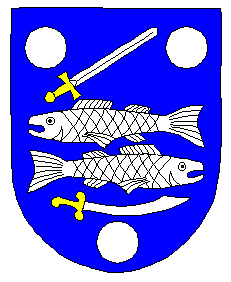Narva: Difference between revisions
Jump to navigation
Jump to search
Knorrepoes (talk | contribs) m (Text replace - "'''Origin/meaning :'''<br>" to "====Origin/meaning====") |
Knorrepoes (talk | contribs) No edit summary |
||
| Line 12: | Line 12: | ||
====Official blazon==== | ====Official blazon==== | ||
Sinisel kilbil hõbedased kaks kohakuti vastassuundades kala ja kaks mõõka ja kolm sõõri. | |||
====Origin/meaning==== | ====Origin/meaning==== | ||
The arms were officially granted on July 24, 1992. | The arms were officially granted on July 24, 1992, but date from 1937. | ||
The two fish refer to the importance of Narva as a fishing harbour. The three cannon balls symbolise that the city has been an important border town during its history. Narva was a longtime Swedish town on the border with Russia (now the Estonian-Russian border). | The two fish refer to the importance of Narva as a fishing harbour. The three cannon balls symbolise that the city has been an important border town during its history. Narva was a longtime Swedish town on the border with Russia (now the Estonian-Russian border). | ||
Revision as of 06:19, 12 October 2012
| Heraldry of the World Civic heraldry of Estonia |
NARVA
County: Ida-Virumaa
Official blazon
Sinisel kilbil hõbedased kaks kohakuti vastassuundades kala ja kaks mõõka ja kolm sõõri.
Origin/meaning
The arms were officially granted on July 24, 1992, but date from 1937.
The two fish refer to the importance of Narva as a fishing harbour. The three cannon balls symbolise that the city has been an important border town during its history. Narva was a longtime Swedish town on the border with Russia (now the Estonian-Russian border).
The sword and scimitar are based on the arms of Karelia and date from the Swedish time (compare also the arms of Finland.
Literature : Image taken from http://www.rk.ee/symb/ and Troels P. Roland
